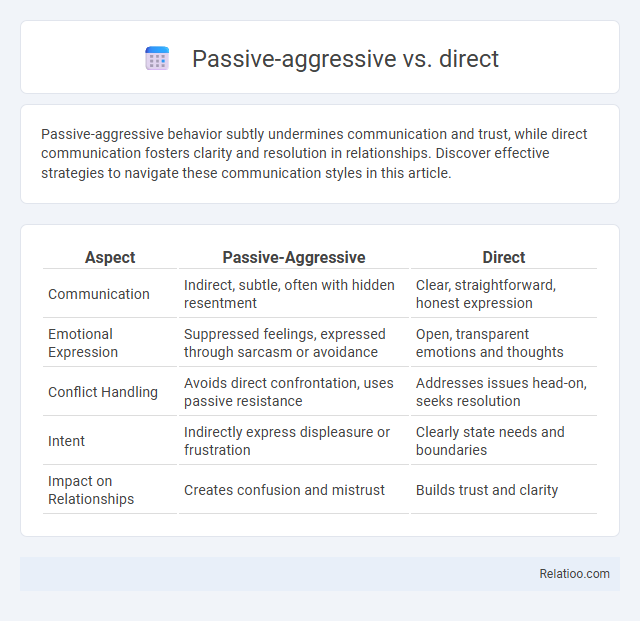Passive-aggressive behavior subtly undermines communication and trust, while direct communication fosters clarity and resolution in relationships. Discover effective strategies to navigate these communication styles in this article.
Table of Comparison
| Aspect | Passive-Aggressive | Direct |
|---|---|---|
| Communication | Indirect, subtle, often with hidden resentment | Clear, straightforward, honest expression |
| Emotional Expression | Suppressed feelings, expressed through sarcasm or avoidance | Open, transparent emotions and thoughts |
| Conflict Handling | Avoids direct confrontation, uses passive resistance | Addresses issues head-on, seeks resolution |
| Intent | Indirectly express displeasure or frustration | Clearly state needs and boundaries |
| Impact on Relationships | Creates confusion and mistrust | Builds trust and clarity |
Understanding Passive-Aggressive Behavior
Passive-aggressive behavior manifests through indirect resistance and hidden hostility, contrasting sharply with direct communication, which involves open and straightforward expression of thoughts and feelings. Recognizing passive-aggressive patterns, such as procrastination, sarcasm, or subtle sabotage, is crucial for addressing underlying resentment without confrontation. Effective management requires fostering environments that encourage honesty and clarity while identifying emotional cues that signal unspoken dissatisfaction.
Defining Direct Communication
Direct communication involves expressing thoughts, feelings, and needs clearly and honestly without ambiguity. It fosters mutual understanding by encouraging open dialogue and minimizing misunderstandings. This communication style contrasts sharply with passive-aggressive behavior, which hides true feelings behind indirect actions, and passive communication, which avoids confrontation by failing to express thoughts openly.
Key Differences Between Passive-Aggressive and Direct Approaches
Passive-aggressive communication is characterized by indirect resistance and hidden hostility, often expressed through sarcasm, procrastination, or subtle undermining, while direct communication involves clear, straightforward expression of thoughts and feelings without ambiguity. Key differences lie in the transparency and effectiveness of conflict resolution, as direct approaches promote openness and mutual understanding, whereas passive-aggressive behavior frequently leads to confusion, mistrust, and unresolved tension. Recognizing these distinctions is vital for improving interpersonal relationships and fostering healthier communication dynamics.
Psychological Roots of Passive-Aggressiveness
Passive-aggressiveness stems from deep-seated psychological roots such as unresolved anger, fear of confrontation, and a desire to maintain control without direct expression of feelings. Unlike direct communication, which openly addresses issues, passive-aggressive behavior manifests through subtle resistance, sarcasm, or procrastination, often masking personal vulnerabilities. Your awareness of these psychological patterns can aid in recognizing and addressing passive-aggressive tendencies for healthier interpersonal dynamics.
Benefits of Direct Communication
Direct communication enhances clarity by ensuring messages are understood without ambiguity, reducing misunderstandings and conflicts. It fosters trust and openness in relationships by promoting honesty and willingness to address issues head-on. This communication style improves problem-solving efficiency and workplace productivity by encouraging constructive feedback and collaborative dialogue.
Signs of Passive-Aggressive Communication
Signs of passive-aggressive communication include indirect resistance, such as procrastination, sarcasm, and subtle sabotage, which contrasts with direct communication marked by clear, honest expression of thoughts and feelings. Passive-aggressive behavior often manifests through silent treatment or backhanded compliments, making it difficult for You to address conflicts openly. Recognizing these signs helps in differentiating passive-aggressive communication from passive or direct styles and improves interpersonal effectiveness.
Impact on Relationships and Work Environments
Direct communication fosters trust and clarity, enhancing collaboration and resolving conflicts efficiently in both personal and professional settings. Passive communication often leads to misunderstandings, frustration, and unmet needs, weakening relationships and reducing productivity. Passive-aggressive behavior creates confusion and resentment, damaging trust and leading to a toxic atmosphere that hinders effective teamwork and morale.
How to Address Passive-Aggressive Behavior
To address passive-aggressive behavior effectively, you must first recognize its subtle signs, such as sarcasm, procrastination, or silent treatment, which contrast with direct communication's clarity and passive behavior's avoidance. Confront your concerns calmly and assertively, encouraging open dialogue to reduce misunderstandings and foster empathy. Your consistent, clear boundaries and willingness to listen create a constructive environment that diminishes passive-aggressive tendencies.
Strategies to Cultivate Directness
Cultivating directness requires clear communication strategies such as engaging in active listening, expressing your needs and feelings honestly, and setting specific boundaries to prevent misunderstandings. You can practice assertiveness by using "I" statements that focus on your experience rather than assigning blame, fostering a respectful and transparent dialogue. Developing these habits reduces the reliance on passive-aggressive behaviors and promotes healthier, more productive interactions.
Choosing the Right Communication Style
Choosing the right communication style depends on clarity and emotional impact; direct communication is clear and assertive, promoting honesty and reducing misunderstandings, while passive-aggressive communication often leads to confusion and unresolved tension due to hidden hostility. Passive communication avoids confrontation but can result in unmet needs and frustration. Understanding the context and desired outcomes helps in selecting between assertiveness, subtlety, or avoidance for more effective interpersonal interactions.

Infographic: Passive-aggressive vs Direct
 relatioo.com
relatioo.com